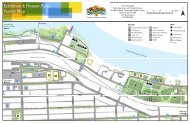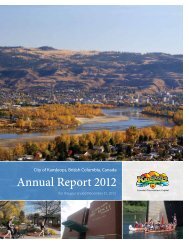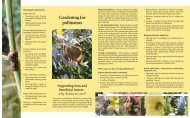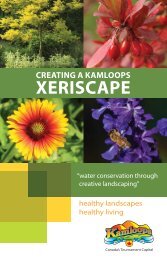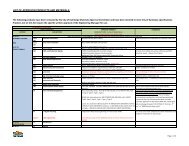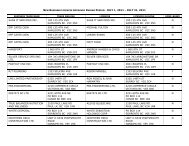Planting the seeds for a sustainable future - City of Kamloops
Planting the seeds for a sustainable future - City of Kamloops
Planting the seeds for a sustainable future - City of Kamloops
You also want an ePaper? Increase the reach of your titles
YUMPU automatically turns print PDFs into web optimized ePapers that Google loves.
HISTORY OF LOCAL AGRICULTUREAn extensive historical timeline detailing <strong>the</strong> agricultural history <strong>of</strong> <strong>Kamloops</strong>has been developed by <strong>City</strong> Planning staff as a living document to provideinsight into past agricultural successes and failures, trends, and potentialopportunities <strong>for</strong> moving <strong>for</strong>ward with <strong>the</strong> industry. The document is alsointended to serve as a guide <strong>for</strong> new farmers interested in farming in <strong>the</strong><strong>Kamloops</strong> region.Post-contact, <strong>Kamloops</strong> has been a self-sufficient food producer since <strong>the</strong>1880s, particularly with <strong>the</strong> introduction <strong>of</strong> <strong>the</strong> railways and <strong>the</strong> ability to shiplocal products to markets. Agriculture has been an important livelihood andeconomic factor in and around <strong>Kamloops</strong> since this time. The Hudson's BayCompany was likely responsible <strong>for</strong> <strong>the</strong> first agricultural activity in <strong>the</strong> areaTo view <strong>the</strong> historical timeline or shareadditional historical agriculture events <strong>for</strong> <strong>the</strong>timeline, please visit:www.kamloops.ca/environment/landagricultureplan.shtmlor contact <strong>the</strong><strong>Kamloops</strong> Museum & Archives at250-828-3576.with <strong>the</strong> cultivation <strong>of</strong> timothy grass <strong>for</strong> <strong>for</strong>age <strong>for</strong> horses used in <strong>the</strong> fur trade and <strong>the</strong> import <strong>of</strong> cattle <strong>for</strong> beef and dairy.Potatoes were <strong>the</strong> main staple produced by <strong>the</strong> Hudson's Bay Company on <strong>the</strong> North Shore site <strong>of</strong> <strong>the</strong> <strong>for</strong>t in <strong>the</strong> mid-1800s. Agreat deal <strong>of</strong> agricultural experimentation took place during this time.The first ranch was started on <strong>the</strong> north side <strong>of</strong> <strong>the</strong> South Thompson River just east <strong>of</strong> <strong>Kamloops</strong> in <strong>the</strong> 1860s. Later in thatdecade, one <strong>of</strong> <strong>the</strong> first <strong>of</strong> many orchards in <strong>the</strong> <strong>Kamloops</strong> area was started at Tranquille.As <strong>the</strong> local agricultural sector grew, so too did its support system. An annual Inland Agriculture Association event thatdisplayed local crops and livestock was initiated, and processing facilities <strong>for</strong> livestock, tomato canning, and grains were built.In <strong>the</strong> late 1800s, <strong>Kamloops</strong> became known <strong>for</strong> its quality and variety <strong>of</strong> agricultural products, and by <strong>the</strong> early 1900s,<strong>Kamloops</strong> was referred to as an “Agricultural Eden”. 3 Agriculture flourished in <strong>the</strong> early 1900s with increased settlement in <strong>the</strong>area, <strong>the</strong> advent <strong>of</strong> <strong>the</strong> <strong>Kamloops</strong> and District Fruit Growers Association, BC Fruitlands, and <strong>the</strong> establishment <strong>of</strong> <strong>the</strong> ThompsonValley Canning Company. Irrigation was implemented; however, many farmers were ultimately <strong>for</strong>ced to leave or turn to cattleranching due to a lack <strong>of</strong> regular irrigation in <strong>the</strong> dry belt. O<strong>the</strong>r support organizations and structures were <strong>for</strong>med such as <strong>the</strong><strong>Kamloops</strong> Agricultural Hall (current site <strong>of</strong> Riverside Park), <strong>the</strong> BC Stock Breeders Association, <strong>the</strong> first <strong>for</strong>mal farmers' market,<strong>the</strong> British Columbia Here<strong>for</strong>d Breeder's Association, BC Cattlemen's Association, BC Sheep Breeders Association, <strong>the</strong> ProvincialWinter Fair, and local agricultural research that helped to support <strong>the</strong> growing local agricultural sector.3 (Inland Sentinel, 1800s)CITY OF KAMLOOPS 13




